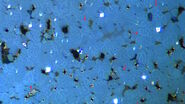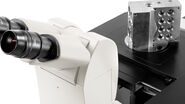Surface characterization methods
Gross features and large defects often can be quickly assessed by the naked eye, finger tips, and low-resolution optical microscopes. However, detailed measurements of finer surface profiles and topographies require advanced surface characterization techniques.
The topography of the surface can be determined with either 2 or 3 dimensional (2D or 3D) measurements, using a variety of high-resolution techniques. It is important to choose the right technique for a specific purpose, because they all have their advantages and limitations. Here, we focus only on some of the most widely used methods in materials science, such as surface probes (stylus, AFM), optical and interferometric methods, and electron beam methods.
The vertical (z) height of points falling on a surface line profile or an area are measured and a 2D contour or 3D map of the surface is displayed. The data is analyzed using defined statistical analysis methods and the resulting values serves as parameters to characterize the surface topography, more specifically, the surface roughness, waviness, lay, and flaws.
Images of the surface topography in 2D or 3D can be acquired using a variety of methods. The most common ones are [1-3]:
- Contact/non-contact profilometry and probe microscopy where the topography data is gathered by a fine probe scanning across the surface;
- Optical profilometry with interferometry, focus and phase detection, or confocal microscopy, using light; and
- Scanning electron microscopy (SEM) using electrons where normally a special software is needed to display 3D topography.
A common probe imaging method is atomic force microscopy (AFM). Although it can achieve very high lateral (XY) and vertical (Z) resolution, acquiring topography data is quite slow and there is a risk that the surface can be altered or damaged. Furthermore, the shape and the size of the probe may change during scanning due to wear and contamination. This phenomenon can influence the appearance of features in the acquired surface topography as the probe and feature geometry are mixed together, a type of convolution [4]. An example is shown in figure 1 below. Obtaining good results with the AFM also requires users to have a certain level of experience.

Optical methods for surface characterization can have a high vertical (z) resolution, but not as high a lateral (xy) resolution as probe methods or electron microscopy. However, the topography acquisition is much faster. This fact means that optical methods can provide surface topography data over large areas making them more practical for reliable, accurate statistical analysis.
SEM can also achieve very high resolution, but imaging is done in a vacuum chamber. If the material is not conductive enough, then charging will occur in the electron beam, so the sample must be coated with a conductive film. Generally, acquiring the image can be time-consuming.
Common surface topography parameters
Roughness
The surface irregularities that form a predominant pattern of roughness on a surface. A smaller surface roughness value indicates smaller and/or fewer irregularities. Examples of parameters which give an indication of surface roughness [1,2,5,6] are shown in table 1 below. Refer also to figure 2 and 3.


Fig. 2: Example of how the parameters Rmax (A), Ra (B), and Rq (C) in table 1 are calculated using a contour profile of an imaginary surface. For Ra the |Z| values in B are averaged. For Rq the Z2 values in C are averaged and the square root of the average value is taken.
Waviness
A measure of surface irregularities with a spacing greater (lower spatial frequency range) than that of the predominant pattern measured for roughness [1,2,5,6]. It is illustrated in figure 3 for an arbitrary surface topography.
Lay
Direction of the predominant surface pattern normally determined by the material production method [1,2,5,6]. The texture aspect ratio (Str) [7], a spatial parameter which indicates whether a surface is isotropic or anisotropic, is useful for determining the lay of a surface. A schematic showing the lay of an arbitrary surface topography is shown in figure 3.
Flaws
Infrequent, isolated irregularities on a surface from specific causes, e.g., scratches, cracks, etc. [1,2,5,6].
International and regional standards for surface topography characterization
The need to check the quality of a surface, to ensure the reliable performance and lifetime of manufactured parts and components, especially for such things as surface topography (also called texture or finish), has led to the development of international and regional standards [3,5,6]. Early standards were reference surfaces with a known topography which could be compared to other surfaces in a qualitative way. Later, the development of an instrument with a stylus, which could measure peaks and valleys when it was scanned across a surface, [3] led to the first standards based on the measurement of the average roughness (Ra).
Further innovations in electronic circuits and the digitalization of analog outputs led to the development of 2D and 3D measurements of topography which could be acquired and recorded with high resolution. These advances helped develop various standards which are used to define topography/texture parameters. Table 2 shows some examples of surface texture standards currently in use worldwide [5,6].
| ISO 4287 | Surface texture: Profile method -- Terms, definitions and surface texture parameters | https://www.iso.org/standard/10132.html |
| ISO 4288 | Surface texture: Profile method -- Rules and procedures for the assessment of surface texture | https://www.iso.org/standard/2096.html |
| ISO 8785 | Surface imperfections -- Terms, definitions and parameters | https://www.iso.org/standard/16210.html |
| ISO 12085 | Surface texture: Profile method -- Motif parameters | https://www.iso.org/standard/20867.html |
| ISO 12780 | Straightness -- Part 2: Specification operators | https://www.iso.org/standard/53623.html |
| ISO 12781 | Flatness -- Part 2: Specification operators | https://www.iso.org/standard/53625.html |
| ISO 13565 | Surface texture: Profile method; Surfaces having stratified functional properties – Parts 1 to 3 | https://www.iso.org/standard/22279.html |
| ISO 25178 | Surface texture: Areal -- Parts 1 to 607 | https://www.iso.org |
| ASME B46.1 | Surface Texture (Surface Roughness, Waviness, and Lay) | https://www.asme.org/codes-standards/find-codes-standards/b46-1-surface-texture |
Table 2: Some international and regional standards for surface topography/texture and characterization.
Summary
Surface metrology is an important field of science and engineering concerning the precise, representative characterization of surface topography, also known as texture or finish. It involves the measurement of a surface’s microscale and sub-microscale features. Surface topography has a critical influence on the mechanical, thermal, optical and electrical properties of materials used to make components, parts, and products. In this report, several important surface metrology techniques and common topography or texture parameters, such as roughness, waviness, and lay, were discussed. Moreover, an overview of international and regional standards for surface topography or texture was given.
References
- K. Miyoshi, Surface Characterization Techniques: An Overview (NASA, 2013) NASA Technical Report NASA/TM-2002-211497.
- N.V. Raghavendra, L. Krishnamurthy, Metrology of Surface Finish, Ch. 9 in Engineering Metrology and Measurements (Oxford University Press, 2013) ISBN: 978-0-19-808549-2.
- P. Nugent, 50 Years of Quality: A Superficial History of Surface Finish, Quality Magazine (April, 2011).
- J.A. DeRose, J.-P. Revel, A comparative study of colloidal particles as imaging standards for microscopy, Journal of Microscopy (1999) vol. 195, iss. 1, pp. 64-78, DOI: 10.1046/j.1365-2818.1999.00490.x.
- Quick Guide to Surface Roughness Measurement: Reference guide for laboratory and workshop, Mitutoyo Bulletin (Dec, 2016) No. 2229.
- G.P. Petropoulos, C.N. Pandazaras, J.P. Davim, Surface Texture Characterization and Evaluation Related to Machining, Ch. 2 in Surface Integrity in Machining, ed. J.P. Davim (Springer, 2010), DOI: 10.1007/978-1-84882-874-2_2.
- F. Blateyron, New 3D Parameters and Filtration Techniques for Surface Metrology, Quality Magazine (May, 2007).





